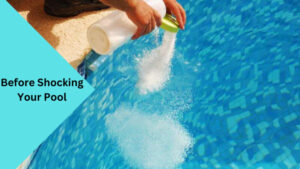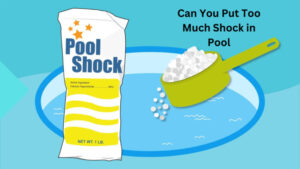Welcome to our comprehensive guide on pool shocking. If you own a pool, you know how important it is to keep the water clean and safe for swimming. Pool shock plays a crucial role in maintaining the crystal-clear waters you desire. But have you ever wondered whether it’s possible to put too much shock in a pool? In this blog post, we will dive deep into the topic and provide you with all the necessary information to understand the right way to shock your pool and ensure an enjoyable swimming experience for you and your family.
What is Pool Shock?
Before we jump into the question of whether you can put too much shock in a pool, let’s take a moment to understand what pool shock actually is. Pool shock, also known as pool sanitizer or chlorine shock, is a chemical compound usually in granular form that helps kill bacteria, algae, and other harmful microorganisms in your pool water. It acts as a powerful disinfectant, making your pool water safe and sanitary.
The Importance of Pool Shocking
Maintaining clean and safe pool water is not just important for the aesthetics; it is crucial for the health and well-being of the swimmers. Regular pool shock treatments are necessary to keep the water free from harmful bacteria and algae. Neglecting to shock your pool can lead to dangerous conditions such as skin rashes, eye and ear infections, and even respiratory problems.
How Does Pool Shock Work?
To fully grasp the concept of shocking a pool and its effects, it is essential to understand how pool shock works. When a pool is shocked, the active ingredient in the shock, usually chlorine, is released into the water. Chlorine acts as a powerful oxidizer, destroying organic compounds and contaminants, such as bacteria and algae. Additionally, shock treatments raise the chlorine levels in the water, killing off any harmful microorganisms and ensuring the pool is safe and clear for swimming.
Can You Put Too Much Shock in a Pool?
Now, let’s address the burning question: Can you put too much shock in a pool? The answer is, yes, it is possible to over-shock a pool. Adding excessive amounts of shock to your pool can have negative consequences, including potential damage to your pool infrastructure, irritations to swimmers’ skin and eyes, and even the formation of harmful byproducts. Therefore, it is crucial to follow the recommended guidelines and avoid using excessive shock.
Factors to Consider Before Shocking Your Pool

Before shocking your pool, it is important to consider a few factors to ensure the process is effective and safe. Here are some key points to keep in mind:
-
Size of the Pool:
The size of your pool is an important factor in determining the appropriate amount of shock to use. Larger pools generally require more shock to achieve the desired sanitization levels.
-
Current Pool Chemistry:
Understanding the current chemistry of your pool water is crucial for shock treatments. Factors such as pH levels, alkalinity, and chlorine levels should be tested and adjusted if necessary before adding shock. This will ensure optimal shock effectiveness.
-
Type of Shock:
There are different types of pool shock available, including calcium hypochlorite and dichlor. Each type has its own recommended dosage and usage instructions. Be sure to choose the appropriate shock for your pool and follow the manufacturer’s guidelines.
-
Frequency of Pool Use:
If your pool sees heavy use, such as during parties or gatherings, it may require more frequent shock treatments as compared to a pool that sees fewer users. Monitor the condition of your pool regularly and shock as needed.
-
Environmental Factors:
Environmental conditions, such as high temperatures and heavy rainfall, can impact the effectiveness of shock treatments. Monitor the weather and adjust your pool maintenance routine accordingly.
How Long Can You Swim After Shocking?
After shocking your pool, it is essential to wait for a certain period before allowing swimmers back in. This waiting period ensures that the shock has effectively dispersed and the pool water is safe for swimming. The duration of this waiting period can vary based on several factors:
- The type and strength of the shock used
- The size and water volume of the pool
- The current water temperature
- The chemical levels in the pool (pH, chlorine, etc.)
As a general guideline, it is recommended to wait at least 8-24 hours before swimming after shocking your pool. However, always refer to the specific instructions provided by the manufacturer of the shock you are using for the most accurate guidance.
How Long After Shocking a Pool Can You Swim?
The length of time you should wait before swimming after shocking a pool can depend on various factors. It is important to understand that shock treatments can temporarily raise chlorine levels, which can cause skin and eye irritations if swimmers enter the pool too soon. Here are some key considerations:
- Chlorine Levels: Test the chlorine levels using accurate pool testing kits. Ensure the levels are within the recommended range before allowing swimmers back in. The appropriate chlorine level usually ranges between 1-3 parts per million (ppm).
- Circulation: The pool water should undergo proper circulation after a shock treatment. This helps in distributing and diluting the shock evenly throughout the pool, reducing the risk of skin and eye irritations.
- Water Clarity: The water should be clear and free from any visible residue or cloudiness before allowing swimming. If the water appears cloudy or if you can still detect a strong chlorine smell, it is advisable to wait a bit longer.
In most cases, waiting for approximately 8–24 hours after shocking the pool ensures that the chlorine levels have stabilized, and the water is safe for swimming. However, always follow the specific instructions provided by the shock manufacturer to ensure the best results.
How to Safely Use Pool Shock
To safely use pool shock and avoid any potential issues, it is important to follow these guidelines:
- Read the Instructions: Always carefully read and understand the manufacturer’s instructions before using any pool shock products. This will ensure that you are using the product correctly and safely.
- Protect Yourself: Wear appropriate personal protective equipment (PPE), such as gloves and goggles, when handling and adding pool shock to the water. This helps prevent exposure to potentially harmful chemicals.
- Dilution: Dissolve the shock in a bucket of water according to the recommended dosage, if required by the manufacturer. Never pour shock directly onto the pool surface, as this can cause staining or damage.
- Add Gradually: Add the dissolved shock solution evenly around the pool or through the skimmer, following the manufacturer’s instructions. Avoid pouring large amounts in one area, as this may cause localized issues.
- Circulate the Water: Run the pool circulation system, such as the pump and filter, for several hours after shocking to ensure proper distribution of the shock throughout the pool.
- Retest the Water: Test the water chemistry after the recommended waiting period to ensure the chlorine levels and other chemical parameters are within the safe range. Adjust if necessary.
- Regular Maintenance: Maintain a regular pool maintenance schedule, including regular shock treatments, to ensure optimal water quality and safety.
By following these guidelines, you can effectively and safely use pool shock to maintain a clean and enjoyable swimming pool.
Conclusion:
In conclusion, pool shocking is an essential part of pool maintenance to keep the water safe, clear, and enjoyable for swimming. While it is possible to put too much shock in a pool, following the recommended guidelines and considering the factors mentioned above will help you avoid any adverse effects. Remember to test your pool water regularly, adjust chemical levels as needed, and allow sufficient time for the shock to dissipate before swimming. By adhering to these best practices, you can ensure a refreshing and safe swimming experience for you, your family, and your friends.
So, go ahead and shock your pool with confidence, knowing that you are providing a clean and healthy environment for all to enjoy!

Greetings, fellow pool enthusiasts! I’m Turner Davis, your dedicated guide to the world of pool care and maintenance. With over a decade of experience in the field, I’ve made it my mission to transform ordinary pools into extraordinary aquatic retreats.

